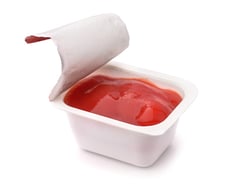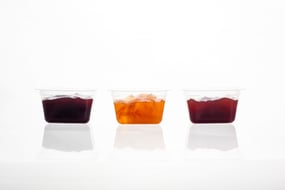 In recent years, increasing pressures on food packaging regarding sustainability and waste reduction, coupled with health & safety concerns, have resulted in development projects and material replacement initiatives to replace PS in food packaging in a wide variety of end-use markets - and packaging for portion control condiments is no exception.
In recent years, increasing pressures on food packaging regarding sustainability and waste reduction, coupled with health & safety concerns, have resulted in development projects and material replacement initiatives to replace PS in food packaging in a wide variety of end-use markets - and packaging for portion control condiments is no exception.
However, as a perishable food with a specific set of requirements for packaging performance, shelf-life expectations and product protection, developing an alternative material solution isn’t as simple as plugging in a new material. Specific characteristics must be maintained, from packaging function, to barrier performance – all in the form of a more sustainable and recyclable product – in order for a material solution to be considered viable for thermoformed & form-fill-seal portion control and array tray condiments, dips, sauces syrups, jams, jellies and more.
Continue reading to learn more about the key requirements for PS replacement in rigid thermoformed & form fill seal condiment packaging & array tray applications.
 Alternative material must deliver key material performance attributes:
Alternative material must deliver key material performance attributes:
Retail and foodservice storage conditions, as well as the distribution environment, necessitate that packaging material meet key material attributes to ensure the product is protected throughout the duration of the shelf-life. Different materials and material structures provide a variety of potential considerations ranging from critical food contact, sealability, taste and odor, shelf-life, top-load, sterilization, filling process and ultimately product food safety.
Key material attributes to consider when selecting alternative materials in thermoformed and FFS condiment packaging & array tray applications include:
- Improvement to organoleptic properties (taste & odor) for an improved consumer experience
- Clarity and contact clarity to provide the consumer with visibility to the product
- Alternative material capabilities that present opportunities for product line extension (i.e. hot fill, microwavability)
- Compliance with Proposition 65 and other regulations regarding the use of PS in food packaging to satisfy consumer health & safety concerns
- Alternative material must maintain packaging function & design features:
In addition to maintaining performance attributes, the material also must meet specifications for packaging protection and design function. Meeting or exceeding material specifications such as stiffness and strength, and barrier protection, are maintained or improved when evaluating a new material is key to ensuring the integrity of the packaging, and ultimately the product protection and consumer experience.
Key functional considerations for thermoformed & form fill seal portion control condiment and array tray applications include:
- Maintains or improves sealing/peeling requirements and function for lidding film
- No compromise to current package performance, for example, column strength and crush
- Meet current OTR & MVTR barrier specifications to meet target shelf-life performance, and incorporate high-barrier materials where necessary
- Evaluate opportunities for enhanced barrier performance and improved shelf-life
- Consider opportunities to improve packaging design as a means of enhancing the customer experience
HIPS/PVDC -> XPP: Download the "Revamping the Array Tray" Case Study to learn more about our material replacement solutions for portion control condiments & array tray applications
- Alternative material must offer compatibility with processing & packaging infrastructure:
 Understanding the processing and sterilization methods utilized in packaging condiment products directly influences material choice and target package performance in order to maximize efficiencies, product safety and ultimately provide a higher level of economic value. Development of alternative material structures must not only deliver on other key requirements in theory, but also in practice on existing packaging and processing equipment.
Understanding the processing and sterilization methods utilized in packaging condiment products directly influences material choice and target package performance in order to maximize efficiencies, product safety and ultimately provide a higher level of economic value. Development of alternative material structures must not only deliver on other key requirements in theory, but also in practice on existing packaging and processing equipment.
Key processing attributes to consider when selecting alternative materials for thermoformed & form-fill-seal portion control condiment and array tray applications:
- Ensure successful processability of new material on existing equipment without compromise to packaging function
- Minimal CAPEX investment to convert/modify existing equipment required to achieve successful processing
- Result in no compromise to current line efficiencies
- Alternative material presents no trimming issues for array trays or requirements for replacement of trimming stations on current FFS lines
- Achieve similar shrinkage to current material solutions to mitigate processing issues
- Improve yield on spend to increase efficiencies during forming, increase output and control cost
- Alternative material must offer improved sustainability and recyclability:
With the rise of take-out and meal delivery, as well as an increased level of concern regarding health and safety, following the COVID-19 pandemic, offerings for single serve condiments, dips and sauces as a method of enhancing safety while continuing to allow consumers to customize their dining experience are becoming more expansive. In parallel, the global initiative to reduce packaging waste has necessitated that sustainable and recyclable packaging is no longer a ‘nice to have’ but a ‘need to have.’ Designing packaging solutions that promote an increased sustainability footprint and simplified recycling is essential to promoting circular economy practices with the ultimate goal of reduced waste.
-
- Material structure has been designed with recyclability in mind for recyclability under a polymer-specific resin ID code
- Delivers down-stream sustainability advantages for an overall reduced carbon footprint
- Packaging solution does not require the use of materials that create recycling challenges and removes the use of problematic materials that would render the packaging not recyclable
- Use of materials that present opportunities for circular-economy business practices such as use of post-consumer recycled products or viable opportunities for re-use into other applications.
-
Today there are more choices than ever when considering packaging materials for portion control condiments and array tray applications, and with increasing industry pressures on sustainability and concerns with Proposition 65, ICPG provides material replacement solutions for thermoformed FFS condiment products using our XPP Polypropylene Solutions to check the box on all key requirements for PS replacement in thermoformed and FFS condiment applications made easy.
Interested to see how XPP stacks up? Download the XPP Property Comparison Cheat Sheet to see how XPP performs in comparison to other packaging solutions:




